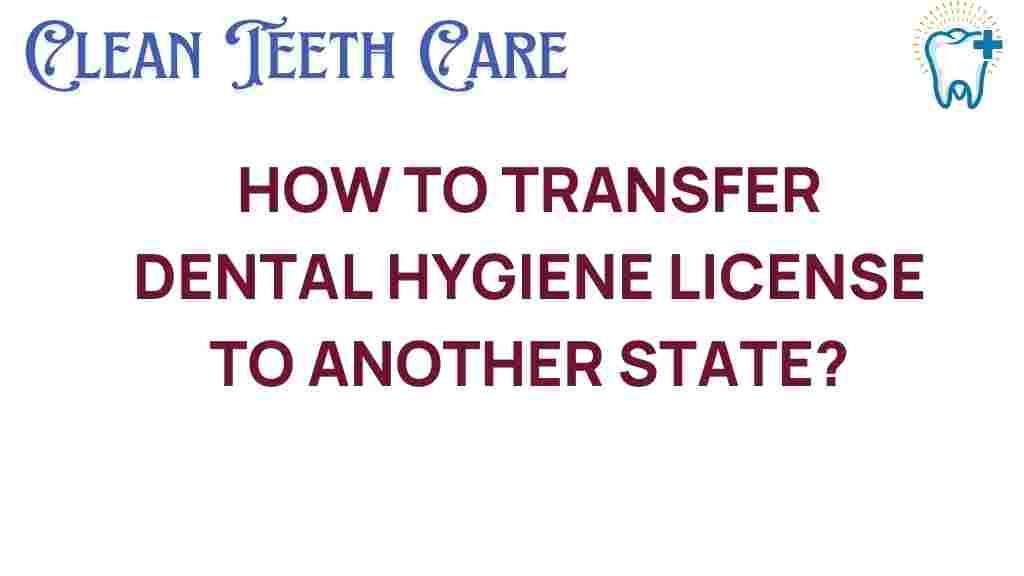As a dental hygienist, your career is not just about cleaning teeth and promoting oral health; it’s about understanding the intricacies of dental hygiene regulations and navigating the complexities of state licensing requirements. If you are considering relocating to another state, understanding the process of dental hygiene license transfer is crucial. This article will provide an in-depth guide on how to successfully transfer your license, the challenges you might face, and how to ensure compliance with varying state regulations.
Understanding Dental Hygiene License Transfer
The transfer of a dental hygiene license from one state to another can be a daunting process. Each state has its own set of rules and regulations that govern the practice of dental hygiene. It is important to familiarize yourself with these requirements to avoid any setbacks in your career.
Why Transfer Your Dental Hygiene License?
There are several reasons why dental hygienists seek to transfer their licenses:
- Job Opportunities: Moving to a new state may open up new job opportunities that align more closely with your career goals.
- Family Reasons: Relocating for family commitments can necessitate a license transfer.
- Professional Development: Some states may offer advanced training or specialized programs that can enhance your skills.
Step-by-Step Process for License Transfer
Here’s a detailed look at the steps involved in transferring your dental hygiene license between states.
Step 1: Research State Regulations
The first step in the license transfer process is to research the licensing requirements of the state you wish to move to. Each state’s dental board will provide information regarding:
- Application procedures
- Fees associated with the transfer
- Continuing education requirements
- Examination requirements (if applicable)
Visit the American Dental Hygienists’ Association for resources and links to state boards.
Step 2: Gather Required Documentation
Once you understand the regulations, gather the necessary documentation. This typically includes:
- Your current dental hygiene license
- Proof of continuing education hours
- Transcripts from your dental hygiene program
- Verification from your current state board
Step 3: Complete the Application
Fill out the application for the new state’s dental board. Be thorough and ensure all information is accurate. Incomplete applications can lead to delays. Pay attention to:
- Application deadlines
- Associated fees
- Submission methods (online, mail, etc.)
Step 4: Submit to Background Checks
Many states require background checks as part of the license transfer process. Be prepared to provide fingerprints and any required fees for processing.
Step 5: Await Approval
After submitting your application, there will be a waiting period. This can vary significantly from state to state. Use this time to:
- Network with local dental professionals
- Explore job opportunities in your new state
- Prepare for any potential examinations or additional requirements
Step 6: Obtain Your New License
Once your application has been approved, you will receive your new dental hygiene license. Make sure to keep a copy of all documents related to the transfer for your records.
Troubleshooting Common Challenges
Despite careful planning, challenges may arise during the license transfer process. Here are some common issues and how to address them:
Issue 1: Incomplete Documentation
Sometimes, applications are delayed due to missing documents. To prevent this:
- Use a checklist to ensure all documents are included.
- Double-check for signatures and necessary copies.
Issue 2: Differences in State Regulations
Each state may have different continuing education requirements. If you find yourself lacking required hours:
- Look for online or local continuing education courses.
- Consider attending workshops or seminars before applying.
Issue 3: Background Check Delays
Background checks can take longer than expected. To mitigate delays:
- Submit your request as soon as possible.
- Stay in contact with the agency conducting the background check for updates.
Continuing Education and Professional Development
As a dental hygienist, continuing education is vital not only for maintaining your license but also for enhancing your career prospects. Many states require a certain number of continuing education credits for license renewal. Here are some options to consider:
- Online courses: Convenient and flexible, online courses can help you meet your continuing education requirements.
- Workshops and conferences: These events offer hands-on experience and networking opportunities.
- Specialized training: Consider pursuing advanced certifications in areas such as periodontics or pediatric dentistry.
Conclusion
Transferring your dental hygiene license between states can be challenging, but with careful planning and understanding of the licensing requirements, you can navigate this process smoothly. Keep in mind the importance of staying updated on state regulations and fulfilling your continuing education to enhance your dental careers. By investing in your professional development, you not only meet licensing criteria but also open doors to new job opportunities and career advancements.
For more resources on dental hygiene and state licensing, feel free to check out our dental hygiene resources page.
This article is in the category Hygiene and created by CleanTeethCare Team
